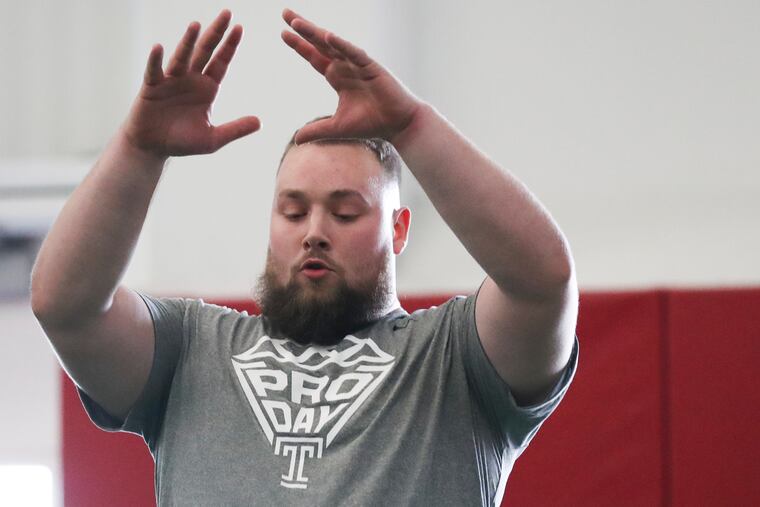The USFL playoff-bound Philadelphia Stars have a local flavor — even if they’ve never played in Philly
Two former Temple players are on the roster for the Stars, who haven't yet played in Philadelphia but will represent the city in the playoffs.

The Philadelphia Stars will be a part of the United States Football League’s first four-team playoff on Saturday against the New Jersey Generals. But connecting the team with the city it represents — but hasn’t played in — has taken some extra initiative.
Stars coach Bart Andrus, who has coached in various professional football leagues for 25 years, wears a black Phillies hat that he bought off MLBShop.com for practices and interviews as a constant reminder.
“It’s a black hat so it matches what we wear, but I wear it every day at practice,” Andrus said. “It’s my way of reminding them that we represent the city of Philadelphia.”
The Stars were one of eight teams to compete in the USFL’s Birmingham, Ala. bubble season. Many out-of-town players and personnel lived in the Sheraton Birmingham Hotel with practices staggered in morning or afternoon slots, spread out among local schools. Regular season games were played at Protective Stadium, where Birmingham Legion FC plays, or Legion Field, the new home to University of Alabama Birmingham.
The playoffs will be held at Tom Benson Hall of Fame Stadium in Canton, Ohio, with the championship game scheduled for July 3.
» READ MORE: Philadelphia Stars coming back as part of the new USFL spring football league
The USFL notably modified certain conventional rules to increase big-play potential and give teams a greater fighting chance late in games.
Stars center C.J. Perez, who played at Northern Illinois and Temple then Ravens and Bills minicamps, joined the Stars after Week 7. It was a Monday night, and he was mowing his parents’ lawn when he got a call from his agent that he would be signed. He was expected to fly down the next morning.
Most of the rule changes don’t directly impact Perez — an added three-point play on extra points, best-of-three overtime shootouts, and allowing two forward passes. But he has found himself bewildered by them.
In his first game, the Stars had a late lead against the Michigan Panthers. Michigan scored, and in traditional football, that would lead to an onside kick to get the ball back.
In the USFL, there’s another option where the kicking team can take a fourth-and-12 play from its 33-yard line. If the kicking team gets a first down, the offense continues from that spot. If it doesn’t, the opposing defense takes over where the ball is downed.
“I had no idea until I saw it happen on the field,” Perez said, laughing. “I was so confused. I thought we just fumbled the kickoff return. Fortunately, they didn’t get it but it was crazy. I’m like, who even thinks of that? That’s crazy.”
Perez is originally from Shawnee, Kan. but spent his last two college seasons at Temple. He doesn’t claim to be from Philly but often acts as the city’s liaison within the team. As does Leon Johnson, who’s originally from Plainfield, N.J. and spent five seasons at Temple (2013-17).
“It’s a little weird because I played in Philly and I know how the fans’ expectations add a little spark to games,” Johnson said. “I was surprised how many guys came up and said, ‘Oh you were at Temple? What years?’ There’s a lot of respect from what we’ve done in Philly from guys all over the place -- Power 5 schools, smaller schools, mid-tier schools, or whatever.”
Johnson bounced around the Alliance of American Football and Canadian Football League before joining the Stars after Week 9, calling the league a well-oiled machine.
The original USFL kicked off its opening season in 1983. It began with 12 teams and lasted three seasons before being bludgeoned by financial troubles, losing over $163 million.
Other leagues like the AAF and XFL have taken similar approaches for an unconventional football league and failed. The former failed from poor financial decisions, and the latter nosedived courtesy of the pandemic.
“The business plan is a little different for this one. Different in a way that they’re more fiscally responsible,” Andrus said. “It’s owned by a media company [Fox Sports] that has tools that other leagues have to pay for. They have it right under their umbrella.”
The league’s first game, between the Generals and Birmingham Stallions on April 16, aired on both Fox and NBC. It was the first time a sporting event aired on competing networks since Super Bowl I in 1967 (CBS and NBC).
For Perez and Johnson, the spring league could potentially be a stepping stone. Former Temple quarterback P.J. Walker worked his way onto the Carolina Panthers in March 2020, becoming the first XFL player to land in the NFL.
“We started out from the first meeting saying we want this football team to make the city of Philadelphia proud,” Andrus said. “We understand the sports history and the climate, what it’s like to be a pro team in Philadelphia. Believe me, we want to make everybody proud of that and hopefully sooner rather than later we’ll play games there.”